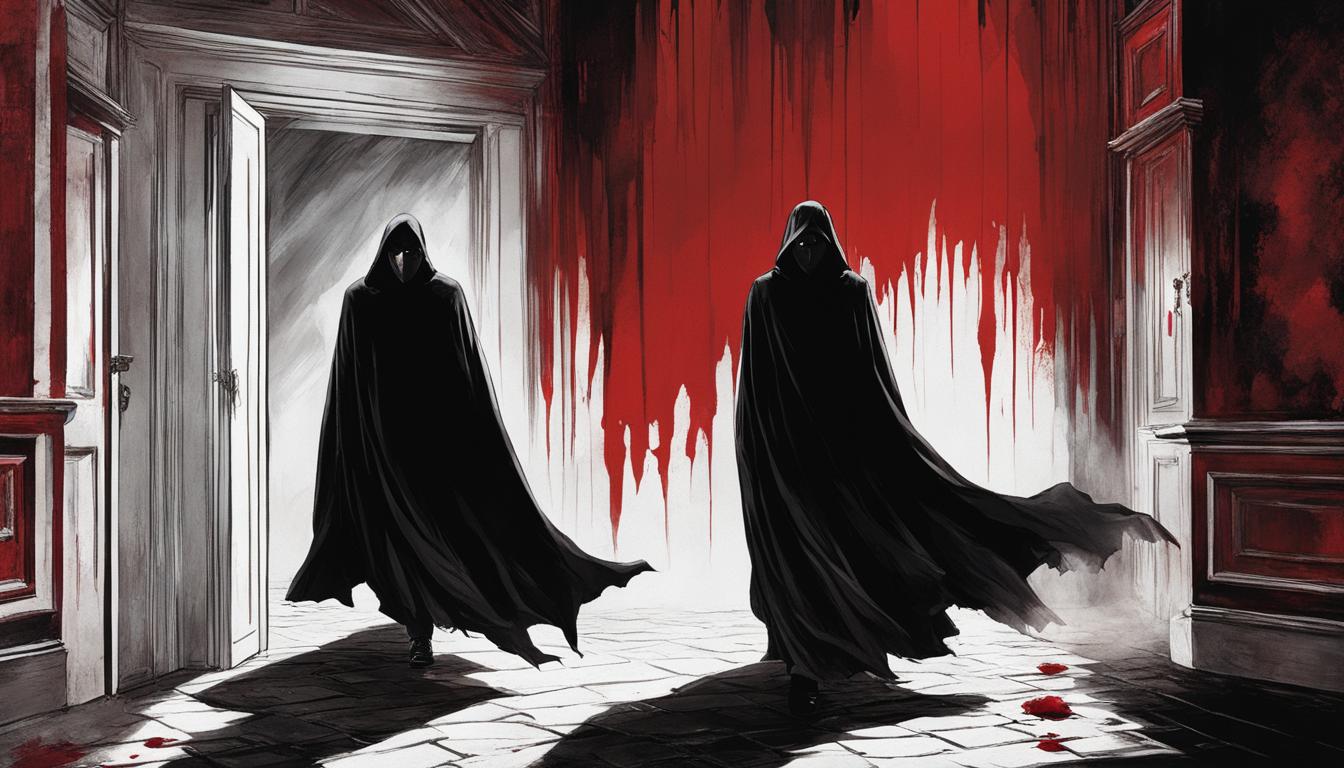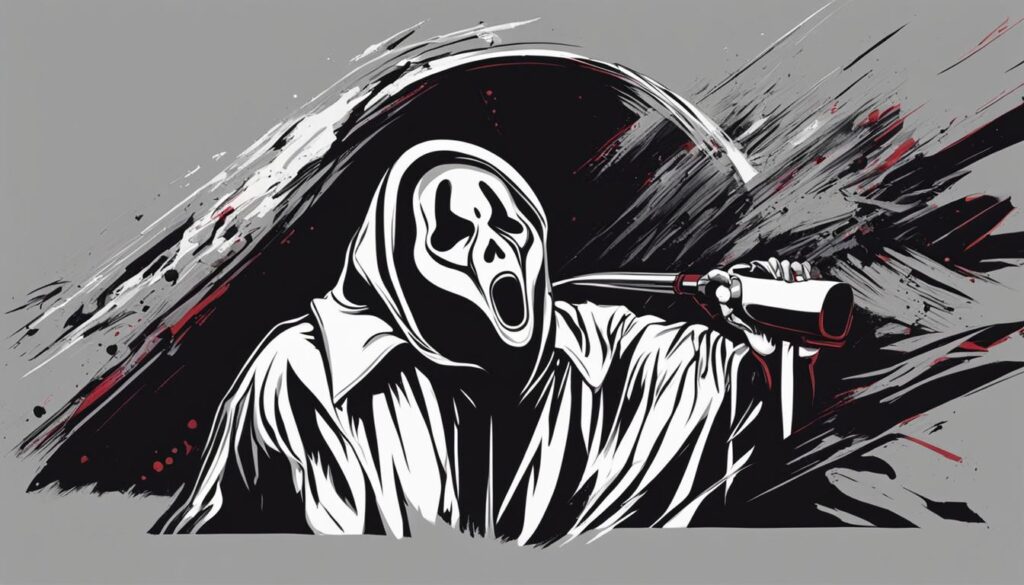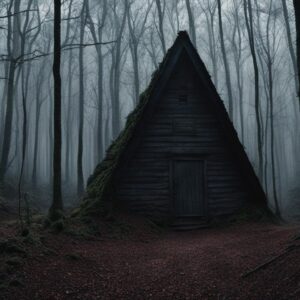Are you ready to embark on a terrifying journey into the world of horror? Join me as we explore the spine-chilling masterpiece that is “Scream (1996).” Directed by the legendary Wes Craven, this slasher film has earned its rightful place as a horror classic. With its captivating storyline, unforgettable characters, and the perfect balance of satire and genuine horror, “Scream (1996)” continues to haunt and delight audiences even after all these years.
Neve Campbell’s portrayal of Sidney Prescott, alongside an ensemble cast including the mesmerizing Ghostface killer, played by an unknown yet terrifying presence, will keep you on the edge of your seat throughout the film. Written by Kevin Williamson, “Scream (1996)” offers a fresh take on the slasher genre, defying expectations and delivering both scares and laughs in equal measure.
Key Takeaways:
- “Scream (1996)” is a horror classic directed by Wes Craven.
- The film successfully combines satire with genuine horror, making it a unique viewing experience.
- Neve Campbell’s performance as Sidney Prescott is unforgettable.
- Written by Kevin Williamson, “Scream (1996)” challenges the conventions of the slasher genre.
- Prepare to be captivated by the terrifying yet entertaining world of “Scream (1996).”
The Self-Awareness of Scream (1996)
One of the defining features of “Scream” is its self-awareness. The film doesn’t just adhere to horror conventions; it actively dissects and subverts them. Characters in the movie openly discuss the “rules” of surviving a horror movie, humorously commenting on the clichés and common tropes that have become synonymous with the genre. This meta-commentary adds a layer of satire to the film and challenges the audience’s expectations of what a horror movie should be.
Throughout “Scream,” the self-awareness is evident in the way it deconstructs and satirizes horror tropes. The characters are not oblivious to the fact that they exist within a horror movie. They recognize the familiar patterns and conventions and often attempt to navigate them in order to survive. This meta-commentary creates a playful yet thrilling atmosphere that keeps viewers engaged and on their toes.
“Do you like scary movies?” – Ghostface
The self-awareness of “Scream” goes beyond the dialogue. It permeates the film’s overall narrative structure and filmmaking techniques. From the opening scene’s homage to classic horror movies to the unexpected twists and turns, the film constantly challenges the audience’s expectations, blurring the lines between reality and fiction. It cleverly reminds viewers that they are watching a horror movie while still delivering genuine scares.
| Horror Conventions | Scream’s Approach |
|---|---|
| Final girl trope | Subverts by having multiple main female characters |
| Jump scares | Uses jump scares strategically, often as misdirection |
| Masked killer | Reveals multiple masked killers throughout the series |
| Predictable plot twists | Keeps audiences guessing with unexpected reveals |
The self-awareness of “Scream” not only adds an extra layer of enjoyment for horror enthusiasts but also serves as a commentary on the genre itself. By openly acknowledging and challenging the established tropes, the film encourages a fresh perspective on horror. It paved the way for future horror movies to experiment with conventions, resulting in a more diverse and innovative genre.
The Characters of Scream (1996)
One of the standout characters in “Scream (1996)” is Randy Meeks, portrayed by Jamie Kennedy. Randy serves as a meta-commentary on the horror movie genre, offering self-aware insights into the rules of surviving a horror movie. He brings a relatable and humorous element to the film, acting as a mouthpiece for the audience’s knowledge and expectations of horror movies. Randy’s character adds depth to the meta-commentary found within “Scream (1996)” and enhances the film’s overall appeal as a horror classic.
Throughout the movie, Randy’s passion for horror movies shines through, making him a relatable and endearing character for horror enthusiasts. His enthusiastic discussions about the tropes and clichés of the genre serve as a reminder that the characters in “Scream (1996)” are aware of their roles within a horror movie. Randy’s presence adds a layer of self-awareness to the film, enhancing the viewing experience for audiences who are familiar with the horror genre.
In addition to Randy Meeks, “Scream (1996)” features a diverse cast of characters who each contribute to the meta-commentary and self-awareness found within the film. From the resourceful protagonist Sidney Prescott to the enigmatic Ghostface killer, each character plays a crucial role in challenging the audience’s expectations of a horror movie. Their interactions and reactions to the unfolding events serve as a constant reminder of the film’s self-awareness and meta-commentary, creating a unique and engaging viewing experience.
The Horror and Suspense of Scream (1996)
One of the reasons why “Scream (1996)” has become such a revered horror classic is its ability to deliver genuine horror and keep viewers on the edge of their seats. The film masterfully creates an eerie atmosphere that permeates throughout, setting the stage for a chilling viewing experience. From the opening scene featuring Drew Barrymore, where the audience is immediately thrust into a suspenseful and terrifying situation, to the bone-chilling climax, “Scream (1996)” consistently delivers on its promise of scares and thrills.
The film’s director, Wes Craven, expertly crafts moments of suspense, utilizing pacing and tension to build anticipation. The audience is taken on a rollercoaster ride of emotions, never quite knowing when or where the next scare will come from. The practical effects used in the film add a visceral quality to the violence, heightening the sense of horror and making the audience feel the chills down their spines.
Furthermore, Neve Campbell’s portrayal of Sidney Prescott adds depth and relatability to the protagonist, making her journey through the film all the more compelling. As viewers invest in her character, they become emotionally invested in the outcome of the story, amplifying the suspense and making the horror feel all the more genuine. The combination of the eerie atmosphere, expert direction, and captivating performances all contribute to the success of “Scream (1996)” as a genuinely terrifying horror film.
The Critics and Flaws of Scream (1996)
While “Scream (1996)” is widely regarded as a genre-defying classic, it is not without its critics and flaws. One critique of the film is its occasionally uneven pacing, particularly in the middle act where the focus shifts to the lives and relationships of the characters. This prolonged character development may temporarily dilute the overall tension and suspense of the film, leaving some viewers wanting more immediate scares.
“Despite its flaws, ‘Scream (1996)’ remains a groundbreaking horror film that effectively blends satire and genuine terror.”
Another criticism of “Scream (1996)” is its reliance on jump scares and the trope of masked killers suddenly appearing. While these elements do contribute to the film’s self-awareness and meta-commentary on horror movie tropes, they can become predictable for some viewers who are familiar with the genre. However, it is important to note that these elements are intentional and serve to enhance the film’s thematic exploration.
Despite these criticisms, “Scream (1996)” continues to be celebrated as an iconic film that defies conventions and redefines the slasher genre. Its flaws are outweighed by its boldness in challenging the status quo of horror cinema, making it an essential watch for any fan of the genre.
The Role of Critics in Evaluating Horror Films
Critics play a significant role in evaluating and analyzing horror films. Their assessments provide valuable insight into the strengths and weaknesses of a film, helping audiences make informed decisions about what to watch. While critics may have varying opinions on specific aspects of a film, their critiques contribute to a broader dialogue about the genre and its evolution. It is through critical analysis that horror filmmakers can continue to push boundaries and deliver innovative and compelling narratives to captivate audiences.
| Flaws of Scream (1996) | Analysis |
|---|---|
| Occasionally uneven pacing | This flaw may result in temporary dilution of tension and suspense, affecting the overall viewing experience. |
| Reliance on jump scares and masked killers | While these elements are intentional and contribute to the film’s meta-commentary, they may feel predictable to seasoned horror movie enthusiasts. |
The Impact of Scream (1996) on the Horror Genre
When discussing the horror genre, it is impossible to ignore the enduring impact of “Scream (1996).” This iconic film not only revitalized the slasher genre but also left an indelible mark on the cultural landscape. Its influence can be seen in the countless imitations and homages that followed, making it a true cultural touchstone.
One of the main reasons why “Scream (1996)” had such a profound impact is its ability to challenge and subvert traditional horror movie tropes. By openly discussing and satirizing the rules of surviving a horror movie, the film brought a fresh perspective to the genre. It encouraged filmmakers to think outside the box and experiment with new ideas, ultimately leading to a wave of creativity in the horror genre.
Another aspect of “Scream (1996)” that contributed to its impact is its memorable characters. The film introduced us to the strong and relatable protagonist Sidney Prescott, played by Neve Campbell, who defied the traditional damsel in distress stereotype. Additionally, the iconic Ghostface killer became an instant symbol of terror, solidifying its place in horror history.
Overall, “Scream (1996)” remains a groundbreaking film that continues to influence the horror genre to this day. Its enduring impact, innovative approach, and unforgettable characters are testaments to its status as a true classic.
Table: The Impact of “Scream (1996)” on the Horror Genre
| Impact | Description |
|---|---|
| Revitalization | The film revitalized the slasher genre, injecting new life and creativity into a genre that was starting to feel stale. |
| Influence | “Scream (1996)” influenced countless horror films that followed, inspiring filmmakers to push the boundaries and challenge conventions. |
| Cultural Touchstone | The film became a cultural touchstone, with its iconic characters and moments referenced and celebrated in popular culture. |
“Scream (1996)” brought a fresh perspective to the horror genre, challenging conventions and inspiring filmmakers to think outside the box. Its impact on the genre is undeniable, solidifying its place as a true classic.
The Legacy of Scream (1996)
Since its release in 1996, “Scream” has become a celebrated horror franchise that has left an indelible mark on popular culture. The success of the original film led to multiple sequels that continued the story and expanded upon the intriguing characters and suspenseful plot. Each installment in the franchise built upon the foundation laid by the first film, delivering new layers of mystery and horror that kept audiences coming back for more.
“Scream” is not only celebrated for its sequels, but it has also made a significant impact on popular culture. The film’s iconic Ghostface mask has become a recognizable symbol in the horror genre, frequently referenced and parodied in various forms of media. Additionally, the franchise’s self-awareness and meta-commentary on horror movie tropes have influenced subsequent horror films, inspiring other filmmakers to experiment with similar concepts.
The enduring legacy of “Scream” is a testament to its status as a classic in the horror genre. Its sequels and cultural impact have solidified its place as a celebrated series that continues to captivate and terrify audiences to this day.
| Table: The Legacy of Scream (1996) | Key Points |
|---|---|
| Celebrated Sequels | The franchise expanded with multiple sequels, each building upon the foundation laid by the original film and introducing new layers of mystery and horror. |
| Pop Culture Impact | The iconic Ghostface mask and the film’s self-awareness have become ingrained in popular culture, referenced and parodied in various media forms. |
| Influence on Horror Films | “Scream” has influenced subsequent horror films, inspiring other filmmakers to incorporate self-awareness and meta-commentary into their work. |
| Enduring Legacy | The lasting impact of “Scream” cements its status as a classic in the horror genre, continuing to captivate and terrify audiences. |
Rediscovering Scream (1996)
“Scream (1996)” is not just a movie; it is a cinematic masterpiece that has stood the test of time. This timeless classic offers a thrilling and unforgettable cinematic experience that continues to captivate and terrify audiences. With its unique blend of satire, genuine horror, and self-awareness, “Scream (1996)” revitalized the slasher genre and set a new standard for horror movies to come.
The film’s impact on the horror genre is undeniable. Its self-awareness and meta-commentary on horror movie tropes challenged the conventions of the genre and inspired countless imitations and homages. “Scream (1996)” encouraged filmmakers to think outside the box and pushed the boundaries of horror, resulting in a wave of creativity within the genre.
As audiences rediscover “Scream (1996),” they are treated to a gripping plot filled with plot twists and a shocking revelation that leaves them stunned. The film’s ability to maintain suspense and keep viewers on the edge of their seats is a central aspect of its cinematic brilliance. The iconic Ghostface mask, chilling moments, and outstanding performances by the cast make “Scream (1996)” a must-watch for both horror enthusiasts and casual viewers alike.
The Impact of Scream (1996)
“Scream (1996)” had a profound and enduring impact on the horror genre. Its innovative take on the slasher genre revitalized it and encouraged filmmakers to explore new creative avenues. The film’s influence can be seen in the subsequent wave of creativity within the genre as filmmakers drew inspiration from its self-awareness and willingness to challenge conventions. “Scream (1996)” continues to be referenced in popular culture, solidifying its status as a cinematic masterpiece.
The Unpredictability of Scream (1996)
When it comes to horror movies, “Scream (1996)” stands out for its ability to keep audiences on the edge of their seats. Unlike typical slasher films, this iconic movie offers a unique blend of horror and mystery, delivering plot twists and shocking revelations that leave viewers stunned. From the very beginning, the film establishes an atmosphere of suspense and intrigue, setting the stage for a gripping whodunnit that keeps audiences guessing until the very end.
Throughout “Scream (1996),” director Wes Craven masterfully navigates the fine line between horror and mystery, creating an experience that is both terrifying and intellectually stimulating. The film keeps viewers guessing with unexpected twists and turns, subverting their expectations and challenging their perceptions of the genre. Just when you think you have it all figured out, “Scream (1996)” pulls the rug out from under you, leaving you shocked and wanting more.
“Scream (1996)” is a rollercoaster ride of fear and intrigue. Its unpredictable plot keeps you guessing until the very end, making it a true standout in the horror genre.
What sets “Scream (1996)” apart from other horror movies is its dedication to keeping the audience guessing. The film’s relentless pacing, combined with its clever use of misdirection and red herrings, ensures that viewers are never quite sure who the true killer is until the shocking reveal. This element of surprise adds an extra layer of excitement and suspense to the film, making it a captivating and unforgettable viewing experience.
In conclusion, “Scream (1996)” is a genre-defying masterpiece that expertly blends horror and mystery. With its plot twists, shocking revelations, and whodunnit narrative, the film keeps viewers on the edge of their seats, never knowing what to expect. Its unpredictability is a testament to its brilliance, making it a must-watch for any fan of the horror genre.
The Impact of Scream (1996) on the Horror Genre
When “Scream (1996)” burst onto the horror scene, it revitalized the genre with its fresh perspective and daring experimentation. The film’s postmodern take on the slasher genre challenged conventions and pushed the boundaries of what horror could be. “Scream (1996)” breathed new life into a genre that was starting to feel stale and predictable, inspiring filmmakers worldwide to embrace their creativity and explore uncharted territory.
With its self-awareness and willingness to deconstruct horror tropes, “Scream (1996)” paved the way for a new wave of creativity within the genre. Filmmakers took inspiration from its unique blend of satire and genuine horror, incorporating meta-commentary and subversion into their own works. The impact of “Scream (1996)” can still be felt today, as horror films continue to experiment and evolve, thanks to the trailblazing example set by Wes Craven and his iconic film.
This revitalization of the horror genre brought about a newfound sense of excitement and unpredictability. Audiences were no longer subjected to formulaic scares and predictable plots; instead, they were treated to innovative storytelling and unexpected twists. “Scream (1996)” ignited a creative fire in the horror industry, leading to an era of bold experimentation and a renaissance of the genre. It proved that horror could be more than just mindless gore and provided a platform for filmmakers to showcase their imagination and artistic vision.
The enduring impact of “Scream (1996)” on the horror genre cannot be overstated. It shattered preconceived notions of what a horror film should be, challenging filmmakers to think outside the box and redefine the genre’s boundaries. Its postmodern approach and commitment to pushing the limits of creativity have left an indelible mark on the horror landscape, ensuring that “Scream (1996)” will continue to be celebrated as a groundbreaking masterpiece.
The Enduring Relevance of Scream (1996)
When it comes to horror movies, few can rival the enduring relevance of “Scream (1996).” This iconic film continues to terrify and captivate audiences, proving its timeless appeal. With its universally terrifying theme, unforgettable performances, and homage to classic horror cinema, “Scream (1996)” remains a must-watch for horror enthusiasts.
The film’s enduring relevance lies in its ability to tap into primal fears and deliver genuine scares. From the opening scene featuring Drew Barrymore’s harrowing encounter with the Ghostface killer, to the suspenseful cat-and-mouse game between Neve Campbell’s Sidney Prescott and her tormentor, “Scream (1996)” keeps viewers on the edge of their seats.
The performances in “Scream (1996)” are truly unforgettable. Neve Campbell shines as the resilient and relatable Sidney Prescott, while Courteney Cox brings a tenacious energy to the role of Gale Weathers. The film’s talented cast of actors adds depth and authenticity to their characters, elevating the horror experience.
Furthermore, “Scream (1996)” pays homage to the classics of horror cinema while adding a fresh and innovative perspective. The film cleverly subverts genre expectations, making it both a love letter to horror and a game-changer in its own right. By blending self-awareness, meta-commentary, and genuine terror, “Scream (1996)” solidified its place as a timeless classic that continues to resonate with audiences.
The Legacy of Scream (1996)
The impact of “Scream (1996)” extends far beyond its initial release. The film gave rise to multiple sequels, each building upon the foundation laid by the original and further developing the story and characters. The franchise remains celebrated and referenced in popular culture, showcasing its lasting influence on the horror genre.
With its enduring relevance, terrifying themes, unforgettable performances, and homage to horror cinema, “Scream (1996)” will continue to be a film that stands the test of time. Whether you’re a horror enthusiast or simply seeking a thrilling cinematic experience, “Scream (1996)” is a must-watch.
Why You Should Watch Scream (1996)
When it comes to outstanding movies in the horror genre, “Scream (1996)” is a true gem that should not be missed. Its impact on the genre, relevance even decades after its release, and pioneering quality make it a must-watch for any cinephile or horror enthusiast.
The film’s impact cannot be understated. “Scream (1996)” revitalized the slasher genre with its fresh perspective and meta-commentary on horror movie tropes. It challenged the conventions of the genre, inspiring filmmakers to think outside the box and push the boundaries of horror. As a result, the film has left an indelible mark on the genre, influencing countless horror films that followed it.
Despite being released over two decades ago, “Scream (1996)” remains relevant and captivating. Its gripping plot, chilling atmosphere, and unforgettable performances by the cast, particularly Neve Campbell, keep viewers on the edge of their seats. The film seamlessly blends genuine horror with self-awareness, providing a thrilling experience that transcends time.
Experience the groundbreaking quality of “Scream (1996)” for yourself. Its impact, relevance, and undeniable pioneering quality make it an outstanding movie that deserves a spot in your watchlist. Prepare to be captivated by its suspense, terrified by its scares, and amazed by its unique take on the horror genre.
The Influence of Scream (1996)
The impact of “Scream (1996)” on the horror genre cannot be overstated. The film’s fresh perspective and willingness to challenge conventions breathed new life into the genre, paving the way for a wave of creativity and innovation in subsequent horror films. The success of “Scream (1996)” inspired filmmakers to think outside the box and explore new creative avenues, resulting in a renaissance of horror cinema.
The film’s self-awareness and meta-commentary on horror movie tropes influenced many horror films that followed. “Scream (1996)” showed filmmakers the power of blending satire with genuine horror, creating a unique viewing experience that captivated audiences. Its impact can still be felt today, with filmmakers continuing to experiment and push the boundaries of the genre.
“Scream (1996)” was a game-changer in the horror genre, revitalizing it with its fresh take and postmodern elements.
One of the key contributions of “Scream (1996)” was its ability to redefine and revitalize the slasher genre. The film injected new energy and creativity into a genre that was starting to feel stale and predictable. Its influence can be seen in the plethora of horror films that followed, as filmmakers sought to capture the same blend of self-awareness, suspense, and genuine terror that made “Scream (1996)” such a groundbreaking film.
Influencing Horror Films Since 1996
The influence of “Scream (1996)” extends far beyond its initial release. It set a new standard for horror films, challenging filmmakers to think differently and take risks. The film’s impact can be seen in the continued experimentation and creativity within the genre, as filmmakers strive to capture the same fresh perspective and unexpected twists that made “Scream (1996)” a cultural phenomenon. It remains a testament to the enduring power of a single film to shape an entire genre.
The Timelessness of Scream (1996)
When it comes to horror movies, few can stand the test of time like “Scream (1996).” This iconic film has left an enduring impact on the genre, captivating audiences with its terrifying plot, unforgettable characters, and innovative self-awareness. As I revisit this cinematic masterpiece, it becomes clear why “Scream (1996)” remains a timeless classic that continues to resonate with viewers of all generations.
“Scream (1996)” is a game-changer in the horror genre, revitalizing it with its fresh take and postmodern elements.
One of the reasons why “Scream (1996)” has stood the test of time is its ability to transcend the confines of a typical slasher film. The movie’s self-awareness and meta-commentary on horror movie tropes add a unique layer of depth and satire that elevates it beyond the realm of mindless gore. By cleverly dissecting and subverting the very rules and clichés it adheres to, “Scream (1996)” challenges the audience’s expectations and keeps them on the edge of their seats.
Furthermore, the film’s enduring impact can be attributed to its ability to deliver an unforgettable cinematic experience. From the chilling opening scene featuring Drew Barrymore to the suspenseful chase sequences and gruesome death scenes, “Scream (1996)” masterfully builds tension and creates an eerie atmosphere that lingers long after the credits roll. The direction of Wes Craven and the standout performances by the cast, including Neve Campbell and the iconic Ghostface killer, contribute to the film’s timeless appeal.
“Its enduring impact on the horror genre showcases its enduring impact on both horror and cinema as a whole.”
As I reflect on the legacy of “Scream (1996)” in the horror genre, its enduring impact becomes even more apparent. The film not only inspired numerous sequels that further developed the story and characters, but it also influenced countless imitations and homages in popular culture. From its self-awareness to its genuine horror, “Scream (1996)” has left an indelible mark on both horror and cinema as a whole, solidifying its status as a must-watch for any fan of the genre.
| Key Takeaways |
|---|
| 1. “Scream (1996)” remains a timeless classic that continues to captivate and terrify audiences. |
| 2. The film’s self-awareness and meta-commentary on horror movie tropes set it apart from other slasher films. |
| 3. The enduring impact of “Scream (1996)” can be attributed to its ability to deliver an unforgettable cinematic experience. |
| 4. The film’s legacy in the horror genre is evident in its influence on subsequent sequels and homages in popular culture. |
Why Scream (1996) is Worth Watching
When it comes to horror movies, “Scream (1996)” stands out for its directorial finesse and its ability to redefine the slasher genre. Directed by Wes Craven, this chilling film takes viewers on a thrilling journey with its gripping plot and moments of genuine horror. From its self-awareness to its meta-commentary on horror movie tropes, “Scream (1996)” offers a unique and intellectually stimulating cinematic experience.
The plot of “Scream (1996)” revolves around a masked killer known as Ghostface terrorizing a small town. What sets this film apart is its ability to keep audiences on the edge of their seats, never knowing who the killer is until the shocking reveal. The combination of suspenseful chase sequences, gruesome death scenes, and the eerie atmosphere created by Wes Craven’s direction makes “Scream (1996)” a must-see for horror enthusiasts.
“Scream (1996)” revitalized the slasher genre with its fresh take and postmodern elements, influencing countless horror films that followed. Its impact can still be felt today, as filmmakers continue to push the boundaries of the genre and explore new creative avenues.
Furthermore, the film’s success lies in its ability to appeal to both horror fans and casual viewers. The iconic Ghostface mask has become synonymous with the horror genre, and the performances by the cast, including Neve Campbell and Courteney Cox, are unforgettable. Whether you’re seeking a chilling plot, a fresh perspective on horror, or simply a gripping cinematic experience, “Scream (1996)” delivers on all fronts.
In conclusion, “Scream (1996)” is worth watching for its directorial finesse, the redefinition of the slasher genre, its chilling plot, and its ability to provide a gripping horror experience. This timeless classic continues to captivate audiences with its innovative approach, making it a must-see for anyone seeking both scares and intellectual stimulation.
Conclusion
After delving into the thrilling world of “Scream (1996),” it is evident that this horror classic has left an enduring impact on the genre. As an iconic film that successfully blends satire with genuine horror, “Scream (1996)” has solidified its place in cinema history. The self-awareness and meta-commentary on horror movie tropes, along with the strong performances and unforgettable antagonist, Ghostface, contribute to its status as a must-watch.
Despite minor flaws such as uneven pacing and some predictability, the enduring influence of “Scream (1996)” is undeniable. Its legacy can be seen in the countless imitations, sequels, and references in popular culture that it has inspired. The film’s ability to captivate audiences with its chilling plot and deliver a thrilling experience is a testament to its enduring relevance.
From Wes Craven’s directorial finesse to the redefinition of the slasher genre, “Scream (1996)” offers an unparalleled cinematic experience. It continues to serve as a timeless classic that pushes the boundaries of horror, challenging viewers’ expectations and delivering both terror and intellectual stimulation. Whether you are a horror enthusiast or simply looking for a thrilling experience, “Scream (1996)” is an iconic film that should not be missed.
FAQ
What is “Scream (1996)”?
“Scream (1996)” is a slasher film directed by Wes Craven, known for its unique blend of satire and genuine horror.
How does “Scream (1996)” satirize the slasher genre?
The film actively dissects and subverts horror conventions, with characters discussing the “rules” of surviving a horror movie and humorously commenting on common tropes.
Who is Randy Meeks in “Scream (1996)”?
Randy Meeks, played by Jamie Kennedy, is a movie buff who serves as the audience’s voice, pointing out the rules of surviving a horror movie and adding humor to the film.
Does “Scream (1996)” deliver genuine horror?
Yes, the film offers genuine horror and suspense, with strong performances by Neve Campbell and chilling moments that create an eerie atmosphere.
Are there any drawbacks to “Scream (1996)”?
Some viewers may find the pacing occasionally uneven, particularly in the middle act. Additionally, the film relies on jump scares and masked killers, which can become predictable.
What impact has “Scream (1996)” had on the horror genre?
“Scream (1996)” has become a cultural touchstone, inspiring imitations and homages, and reinvigorating the horror genre by encouraging filmmakers to challenge conventions.
Are there any sequels to “Scream (1996)”?
Yes, the success of the film led to multiple sequels that further expanded the story and characters.
Why should I watch “Scream (1996)”?
“Scream (1996)” is an outstanding movie that offers a thrilling and intellectually stimulating experience, revitalizing the slasher genre and setting a new standard for horror movies.
How has “Scream (1996)” influenced the horror genre?
The film has had a lasting impact, inspiring filmmakers to think outside the box and explore new creative avenues within the genre.
Is “Scream (1996)” still relevant today?
Yes, “Scream (1996)” remains relevant due to its enduring impact, unforgettable performances, and its homage to the classics of horror cinema.
Why is “Scream (1996)” considered a timeless classic?
The film offers a unique cinematic experience that continues to captivate and terrify audiences, making it a must-watch for horror enthusiasts.







